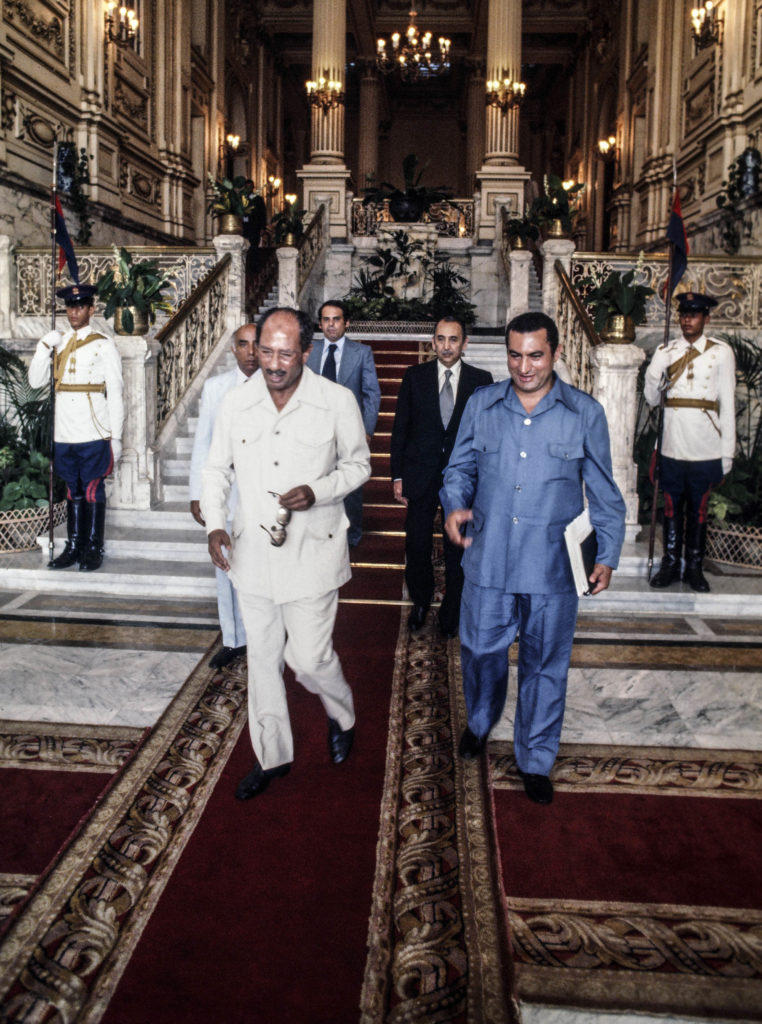Ousted Egyptian president Hosni Mubarak sits inside a cage in a courtroom during his verdict hearing in Cairo on June 2, 2012. A judge sentenced Mubarak to life in prison after convicting him of involvement in the murder of protesters during the uprising that ousted him last year. (Photo by STR/AFP)
NEWS ANALYSIS
Mohamed Hosni Sayyid Mubarak, May 4 1928 to February 25 2020
Hosni Mubarak was never supposed to be the president of Egypt. When Anwar Sadat made Mubarak his vice-president, in 1975, it was not for his leadership qualities but for the absence of those qualities: the career army officer, without any obvious charm or political base, and hampered by his famously unsophisticated accent. He posed no threat to the president.
The threat to Sadat came from another direction. In 1981, Sadat was assassinated in a hail of bullets, fired by soldiers in his own army with ties to a fundamentalist group. Sitting next to Sadat when he was killed was his vice-president, Mubarak, who sustained a minor hand injury in the attack. One week later, Mubarak was confirmed as Egypt’s new leader.
 Photograph taken during the assassination of Anwar Sadat (1918-1981) President of Egypt, Egypt. Dated 20th Century. (Photo by: Universal History Archive/Universal Images Group via Getty Images)
Photograph taken during the assassination of Anwar Sadat (1918-1981) President of Egypt, Egypt. Dated 20th Century. (Photo by: Universal History Archive/Universal Images Group via Getty Images)
It would be another 30 years before Egyptians knew another head of state. In that time, Mubarak forged the archetypal Middle Eastern military dictatorship, with himself at the helm and his generals enmeshed in both politics and business. He did it with strong support from the United States, which gave Cairo billions of no-strings-attached dollars every year in return for continued peace with Israel. Other Arab leaders accused him of selling out, but Mubarak didn’t seem to care: he invested these funds into ensuring his own survival, building a state-of-the-art military and expanding the reach and powers of the ruthless and much-feared mukhabarat (secret police).
The money was also spent on the government’s vast food and fuel subsidy programmes, which formed the basis of an unwritten social contract between the president and the population: as long as bread remained cheap, few complained publicly when Mubarak locked up members of the Muslim Brotherhood or blatantly rigged elections in his favour.
The end of three decades of rule
But the rapid growth of Egypt’s population made these subsidies impossible sustain. By the late 2000s, the country’s population of about 80-million was double what it was when Mubarak assumed power in 1981. Today, it is more than 100-million. To crack down on growing resentment, Mubarak’s regime became ever more intolerant and authoritarian, torturing and detaining anyone perceived to be an enemy, with groups such as the Muslim Brotherhood coming in for special persecution.
 Egyptian President Anwar al Sadat (1918 – 1981) and Vice-President Hosni Mubarak walk through the halls of King Farouk’s Palace in Cairo, Egypt, 1977. (Photo by David Hume Kennerly/Getty Images)
Egyptian President Anwar al Sadat (1918 – 1981) and Vice-President Hosni Mubarak walk through the halls of King Farouk’s Palace in Cairo, Egypt, 1977. (Photo by David Hume Kennerly/Getty Images)
Year after year, however, the pressure built. Mubarak reportedly survived six assassination attempts, although these were all hushed up. But his presidency could not survive forever. In 2011, finally, Egypt exploded.
The so-called Arab Spring brought millions of people into Cairo’s Tahrir Square, all of whom demanded Mubarak’s head. So vast were the numbers of protesters that the security apparatus had no chance of keeping the crowds under control, even when they released and armed prisoners to attack the demonstration. When Mubarak tried to calm the situation, via stilted speeches on national TV — three decades on, some Egyptians were still mocking his accent — he appeared out of touch and inflexible.
Crucially, even as protesters and policemen exchanged Molotov cocktails in Tahrir Square, his army stayed resolutely neutral. “The army and the people are one hand,” the protesters chanted, some even clambering onto tanks for a better angle from which to lob rocks towards pro-government thugs.
Mubarak’s generals had read the prevailing mood better than the president. Ultimately, their loyalty was with themselves rather than their commander-in-chief. It is a decision that has paid off, both politically and financially.
Mubarak was forced to resign on February 11 2011, holing up at a beach house by the Red Sea, where his health began to deteriorate. The Muslim Brotherhood’s Mohamed Morsi was elected as president in Egypt’s first-ever credible election in 2012. That same year, Mubarak was charged and convicted to life imprisonment in connection with the murder of Arab Spring protesters, appearing in court behind the bars of a steel cage.
The generals, however, weren’t finished. In 2014, Field Marshal Abdel Fatah el-Sisi overthrew Morsi in a military coup, and installed himself as president. In 2015, most of Mubarak’s convictions were overturned, and in 2017 he was released from prison, allowed to die a free man in an Egypt which, although his portrait no longer hung in every government office, would have been all too familiar to him: a military dictatorship in which generals run both the government and the economy; political opponents are routinely tortured, jailed and killed; and the state keeps subsidising basic goods in a desperate effort to revive the social contract.
This is, after all, the state that Mubarak built — even if he is no longer around to lead it.